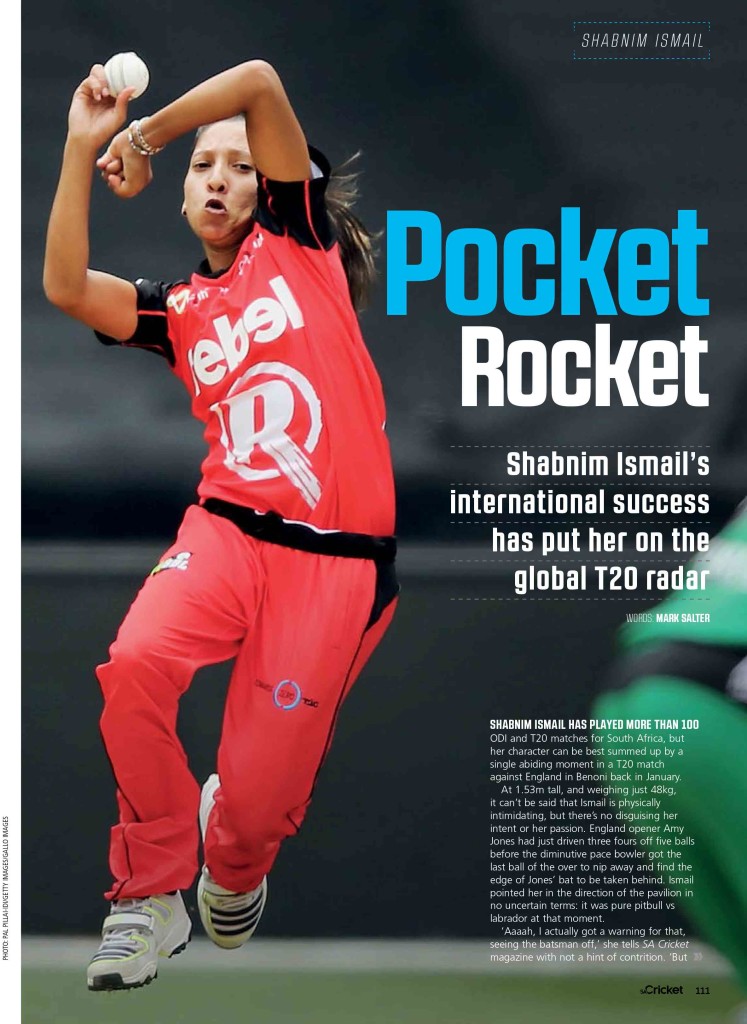We revisit Ismail’s plans for the season ahead, featured in the latest edition of SA Cricket magazine.
Shabnim Ismail has played more than 100 ODI and T20 matches for South Africa, but her character can be best summed up by a single abiding moment in a T20 match against England in Benoni back in January. At 1.53m tall, and weighing just 48kg,it can’t be said that Ismail is physically intimidating, but there’s no disguising her intent or her passion. England opener Amy Jones had just driven three fours off five balls before the diminutive pace bowler got the last ball of the over to nip away and find the edge of Jones’ bat to be taken behind. Ismail pointed her in the direction of the pavilion in no uncertain terms: it was pure pitbull vs labrador at that moment.
‘Aaaah, I actually got a warning for that, seeing the batsman off,’ she tells SA Cricket magazine with not a hint of contrition. ‘But it was the adrenalin rush. I think I am naturally aggressive, and I was quite worked up. One of my role models is Dale Steyn, and he has the same thing; it’s just us expressing ourselves.’
Ismail has expressed herself to remarkable effect since making her debut for the Proteas women in 2007, when she had just turned 18. She has taken 88 ODI and 58 T20 wickets at an economy rate of 3.53 and 5.7 respectively, and has recently come to the fore in the burgeoning commercial T20 market.
Her initial approaches to last year’s Women’s Big Bash League went unanswered, but in November, she received a call out of the blue from the Melbourne Renegades, offering her a two-match stint as cover for the otherwise engaged Rachel Priest. Her impact was immediate: 3-10 in front of 30 000-plus spectators in the Melbourne derby at the MCG, leading to a five-wicket win. While she was not as fortunate in the return fixture (0-18 off three), Ismail had shown the selectors enough for them to offer her a full contract for this year’s event. That was followed by a contract with the Yorkshire Diamonds in England’s Kia Super League.
‘It is a different world out there,’ she said. ‘It’s such an important part for us South Africans because all the games are televised and the whole world gets to recognise you. In South Africa, it is a bit demoralising. Out there you get people taking your picture and asking you for your autograph and when you come back it’s back to normal and there’s not so much interest. It is changing, though, and people are starting to recognise us as cricketers, but there it is so much bigger.’
Recognition on this scale has been a long time coming for one of the stalwarts of the Proteas team.
Despite her size, her snarling aggression has made her the standout bowler, whether working in tandem with the more sedate pace of Marizanne Kapp or the contrasting spin of Dane van Niekerk.
She was officially clocked at 122km/h in the Big Bash, but says she has reached 128 in the recent World T20. But more’s the wonder, as she has had little formal training since being discovered playing soccer by scouts for Primrose Cricket Club. She was pushed and encouraged by the enthusiasm of her grandfather and mother, both sports mad.
‘My grandpa really pushed me to play cricket and watch cricket with him. I started playing at school, at Cravenby Secondary High, but there was not much organised there. It wasn’t a private school, and I played in the roads. Then, one day – when I was actually playing soccer at the time – a lady approached me and asked me if I played cricket and she got me to join Primrose.
It moved rapidly from there, being called up almost immediately into the WP U16 team, where she was known as ‘The Demon’. A few months later she was called into the WP senior squad and progressed within months to making her international debut, against Pakistan in January 2007.
She owes everything, she says, to Henry Williams, the seven-cap Proteas ODI bowler who found a more rewarding niche coaching, especially among the youth and the women’s national team and who was alerted to her potential when South Africa played West Indies at his home base, Boland Park, back in 2010.
‘I was asked to take a look at an up-and-coming fast bowler, but I didn’t know what to expect when I first saw her. I was immediately struck by her natural athleticism, agility and speed,’ he says. In contrast to Ismail’s claim that she is naturally aggressive, Williams said that was a major focus of their training.
‘I told her that we can make her the No 1 fast bowler in the women’s game. We worked on her swing, her yorkers, but then I told her, “there has to be some fear”. I wanted her to be someone the other teams talked about. She is not a naturally aggressive girl, so we introduced the bouncer. Of course, it all had to be controlled. And we had to work on her attitude. I saw her in one game against West Indies, being taken apart by Deandra Dottin, and I could see the work going out of the window. I told her, ‘’there are times, no matter how good you are, you’re going to get hit, so get used to it’’. She has taken that all on board and I reckon she will be the greatest fast bowler this country has seen.’
Williams and Ismail are still in constant communication, but Williams fears there could be some regression, as the Proteas women do not have a dedicated bowling coach. ‘We talk on the phone and discuss all aspects of the game, but it’s not ideal. You need to be on the spot,’ he says. Ismail agrees. ‘To not have a bowling coach at the level we are playing makes it very hard, especially for the young players coming in,’ she says.
Ismail’s strength is in her natural rhythm, although she claims she is working on her upper body strength. It doesn’t show yet. She is rather proud of the fact that she has never topped 50kg. ‘Since I was a baby, probably; no matter what I eat. I can eat anything and I still won’t break 50kg. It runs in the family.’
Ismail is also keen to expand, professionally. She is determined to improve her batting to rise up the batting order and be known as an all-rounder. ‘I am the only left-hander in the lineup, so it would be useful to bat higher up,’ she says.
As any bowler would, Ismail sees the team’s batting as a weak spot. ‘At the national academy we can work on that, and the only thing I really worry about is our mental skill. It’s not that we don’t have the cricket skill, it’s more about how we go about things.’
Regardless, Ismail and the rest will need to be in form over the coming months, not only to impress the overseas crowds, but also to keep South Africa ahead of the game on the road to the World Cup in 2017. The Proteas travel to Ireland in July for three ODIs, but without Ismail’s services as she takes up her post with the Yorkshire Diamonds.
Then, come October, the Proteas have a vital series against New Zealand, which they must win if they are to stay in the ICC World Championship top four, which gives them automatic entry into the 2017 World Cup in England. Missing that will result in a play-off series between the bottom four and six regional qualifiers.
Written by Mark Salter, a freelance sports writer at Highbury Safika Media.







